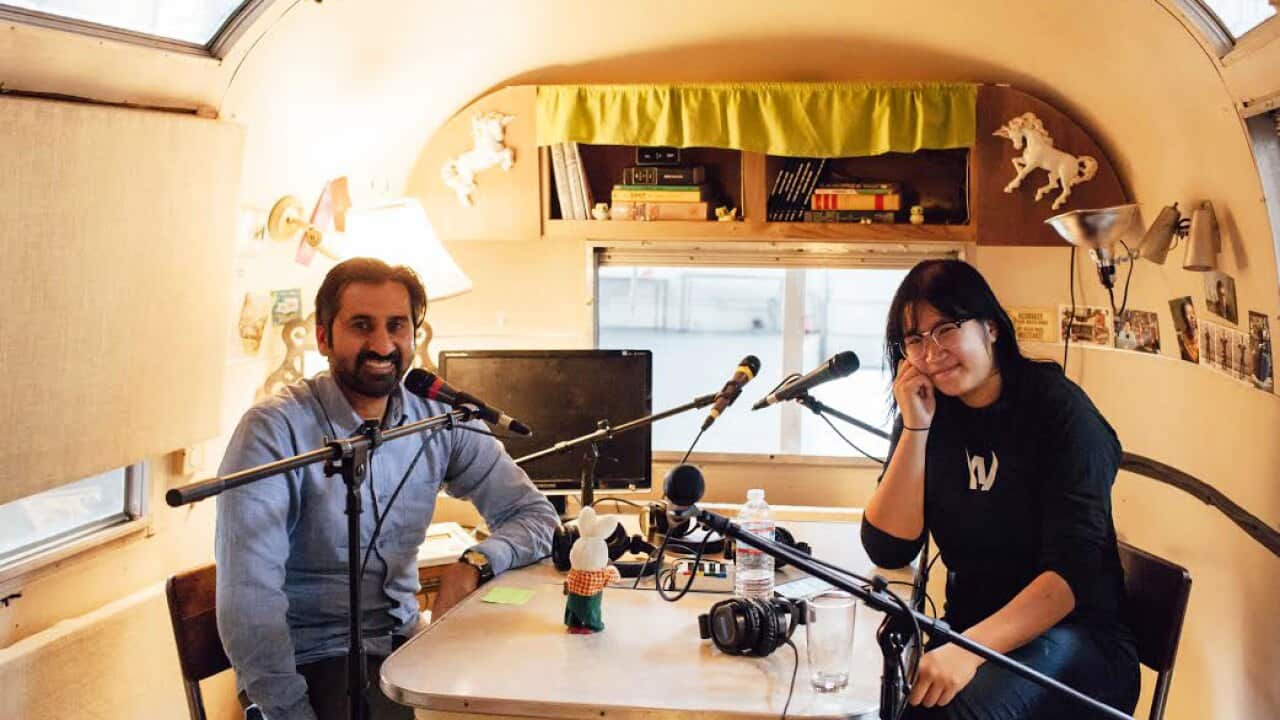On the flight home from a prestigious writer’s residency, Indian-American journalist caught sight of a text that snapped him out of his reverie. “[We were] stuck on the runway. A white man sitting next to me was texting his friend [and he] said, ‘I am sitting next to a stinky Indian who smells like curry’.” says Janmohamed.
“At my writer’s residency I felt an acceptance I hadn’t felt in years, it was incredible and empowering. But there on the plane next to this white guy, I was just another ‘smelly indian’. It hurt, but it also embarrassed me. And I kept thinking, 'do I smell like curry?' Even though I hadn’t eaten curry in weeks.”
Thus begins an episode of , a Portland-born podcast that Janmohamed co-hosts with chef and . Now in its second season, the show looks at race, class and gender in the food world and features interviews with chefs, photographers, writers and stand-up comedians about their food experiences in an “overwhelmingly white industry”.
A typical episode may cover anything from Pulitzer-winning author ’s take on , to the , or a poet reciting a work about the racially charged history of the word “curry”, in an episode suitably titled “”.
“What’s interesting to me and Zahir is that food writing, like travel writing, tends to get mired into really imperialistic, Orientalist framings of non-white culture,” Ho speaks to SBS from , where she’s working on the show remotely.
But there on the plane next to this white guy, I was just another ‘smelly indian’. It hurt, but it also embarrassed me.
“Back in 2016, when Racist Sandwich launched, there wasn’t really a big conversation around it. People still thought it was kind of a free-for-all – culturally – to write about other people’s food and not think about its context.”
In response, the show asks questions that other food programs won’t: Why are ‘ethnic’ dishes always being elevated? Why do magazine editors love placing in photos of Asian food? And what happens when your entire identity is reduced to a single dish?
And while fans will likely find themselves thinking more critically about how they eat — the tone of the show is never educational or accusatory. This is because neither Janmohamed or Ho are interested in spending hours on a project “”. Instead, the pair invites us to sit with the discomfort — by listening to stories that tend to get lost in the churn of the food media.
“There is a lot of talk about how Portland’s a great food city. [But] the scene is mainly dominated by restaurants serving food from non-white cultures that’s cooked by white people. That in itself isn’t inherently bad, it’s just a symptom of something that’s much deeper.”
One of the deeper issues, it seems, is a lack of diversity in food journalism — even in overtly cosmopolitan cities.
Back in 2016, when Racist Sandwich launched, there wasn’t really a big conversation around it. People still thought it was kind of a free-for-all – culturally – to write about other people’s food and not think about its context.
Lee Tran Lam, food writer and creator of Sydney-based podcast thinks modern food criticism can benefit from more voices of colour. “The world of food is so multicultural, our menus are so multicultural. Shouldn’t the people covering these stories also reflect that diversity?” she asks.
Since the podcast’s launch in 2012, Lam has interviewed everyone from high-profile chefs like Massimo Bottura and Ferran Adria to local chocolatiers and gelato-makers – all given equal airtime.
“Food worth covering isn’t just high-end, award-winning food. And ‘ethnic food’ isn’t just cheap street food. Having diverse coverage matters. Hearing the stories behind key dishes really matters, people speaking up for under-represented voices really matters,” she says.
Across the restaurant world, an eerie homogeneity also exists in the top tiers of the industry. People of colour – especially women of colour – are generally stuck in the lower rungs of the industry, working in fast food, back-of-house or janitorial jobs.
“We see it all the time: why are the maître ds, sommeliers, and the servers of the top restaurants all white men, with the exception of a few white women?” asks Ho. “Workers are often butting up against the illusion that the food industry is one of the last true meritocracies – that if you work hard, you’ll be recognised.”
Across the US, found 53 percent of back-of-house jobs are done by people of colour. In fine-dining restaurants, "81 percent of management is white, often male". Closer to home, a reported women earn an average of 7.5 per cent less than men in hospitality.
“It’s interesting to see how the unfolds and how it hits the restaurant industry. It explains to a lot of people why there aren’t a lot of women in top positions in the food world – because basically, [the kitchen] culture is still rampant with sexism and harassment. We don’t talk about that, and we need to.”
In this sense, taking a step back and questioning the standards we have inherited would help challenge the idea of who gets to be ‘worthy cooks’, says Ho.
For Lee Tran Lam, part of the process has to do with taking the time and care to etch out the full humanity of a food worker’s story.
The world of food is so multicultural, our menus are so multicultural. Shouldn’t the people covering these stories also reflect that diversity?
“I usually start my interviews with this question: ‘When you were growing up, was food a big deal?’ It’s a revealing way for people to describe what kind of home they grew up in and what was on their dinner table … without implying any judgment about their cultural background.”
This has opened up her listeners to the private worlds of chefs that’s layered with their most elemental memories – images of ; dodging ; or being fed cleaver-hacked chocolate wedges on bread . In other words – what makes the makers of our food who they are.
And it’s this openness to other people’s stories that will help us question our own bias about certain cuisines. “There’s a prevailing attitude that devalues food from cultures that aren’t white,” says Ho. “We’re expected to pay a small amount of money for a bowl of pho, for example. But it’s no less work than making a steak – it’s still food, and it’s going to nourish you. Being more open to valuing that cuisine will help restaurateurs. And we need to be okay with that.”






